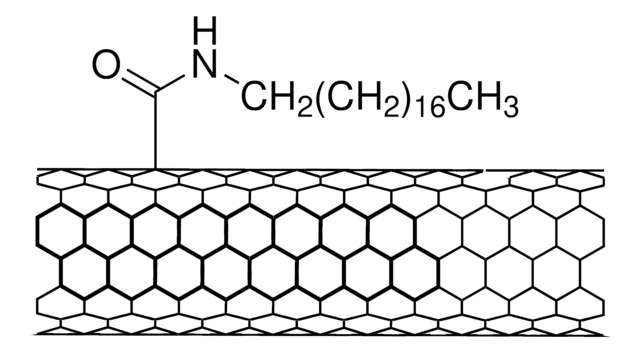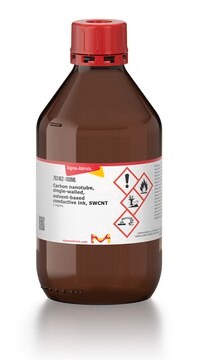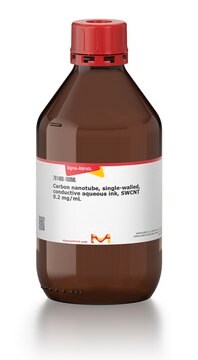639230
Carbon nanotube, single-walled
polyaminobenzene sulfonic acid functionalized, 75-85%carbon basis, D × L 1.1 nm × 0.5-1.0 μm , bundle dimensions
Sinonimo/i:
Carbon nanotube, single-walled, PABS functionalized, SWNT, PABS functionalized
About This Item
Prodotti consigliati
Nome del prodotto
Carbon nanotube, single-walled, polyaminobenzene sulfonic acid functionalized, 75-85% carbon basis, D × L 1.1 nm × 0.5-1.0 μm , bundle dimensions, avg. no. of layers, 1
Saggio
75-85% carbon basis
Stato
powder
PM
average Mw 400-600 g/mol (PABS)
Caratteristiche
avg. no. of layers 1
Grado di funzionalizzazione
65% (PABS, typical)
D × lung.
1.1 nm × 0.5-1.0 μm , bundle dimensions
Impurezze
4% metals
Solubilità
ethanol: 0.05 mg/mL
DMF: 0.1 mg/mL
H2O: 5.0 mg/mL (As determined by near-IR absorbance spectroscopy.)
Gruppo funzionale
sulfonic acid
Categorie correlate
Descrizione generale
Applicazioni
Confezionamento
Nota sulla preparazione
Risultati analitici
Avvertenze
Warning
Indicazioni di pericolo
Consigli di prudenza
Classi di pericolo
Eye Irrit. 2 - STOT SE 3
Organi bersaglio
Respiratory system
Codice della classe di stoccaggio
11 - Combustible Solids
Classe di pericolosità dell'acqua (WGK)
WGK 3
Punto d’infiammabilità (°F)
Not applicable
Punto d’infiammabilità (°C)
Not applicable
Dispositivi di protezione individuale
dust mask type N95 (US), Eyeshields, Gloves
Scegli una delle versioni più recenti:
Possiedi già questo prodotto?
I documenti relativi ai prodotti acquistati recentemente sono disponibili nell’Archivio dei documenti.
I clienti hanno visto anche
Articoli
Carbon nanotubes are materials that possess remarkable properties and offer extraordinary possibilities.
Carbon nanotubes (CNTs) have received much attention since their discovery in 1991 by Sumio lijima1 due to their excellent mechanical, electrical, and optical properties.
A nanocomposite is typically defined as a mixture between a host material (e.g., polymer matrix) and nanofillers with at least one dimension of less than 100 nm.
Single-walled carbon nanotubes (SWCNTs) are promising materials for use in the active channel of field-effect transistors (FETs), photoabsorbing layers of solar cells and photodetectors because of their ultrafast charge transport mobility.
Il team dei nostri ricercatori vanta grande esperienza in tutte le aree della ricerca quali Life Science, scienza dei materiali, sintesi chimica, cromatografia, discipline analitiche, ecc..
Contatta l'Assistenza Tecnica.









